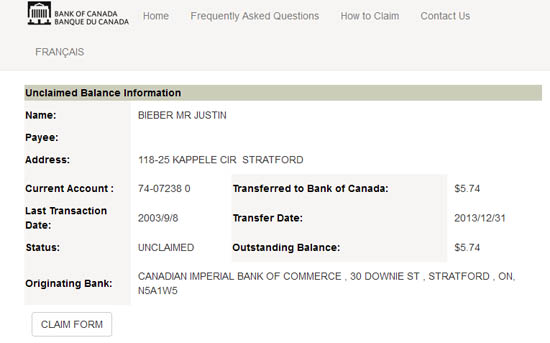My children have a collection of Canada Premium Bonds given to them over the years by a kind relative. The rate of return in recent years on these bonds has been shockingly low but the principal is safe and the donor is happy. Recently, though, I’ve been able to coax the donor into allowing me to move some of the money into another investment for the children which will at least keep up with the rate of inflation so the value of the gift is not diminishing over time. That led me to wonder how I could determine the value of any given Canada Savings Bond or Canada Premium Bond if it is redeemed early.
How to Look Up the Cash Value of a Canada Premium Bond With Compound Interest Which Has Not Matured
I knew the government had the redemption values for Canada Savings Bonds on the internet but it took a bit of clicking to get to the correct page.
To check the value of your bond, first check which series it is. The series will be part of the numbers on the front of the printed bond. Look for CP and a couple of digits.
Next, go to the redemption tables available online at
http://www.csb.gc.ca/fis/redemption-tables-s40/?type_select=1&bond_type=P&interest_type=C
Click on the link with the name of your bond series. For example, I clicked on CP52.
The table will display the value of each of the different sizes or face values of bonds listed across the page in columns, such as $100, $300, $500, $1000 etc.
You look for the correct column, then read down the page to the month you plan to cash the bond. For example, I looked at the December 2015 column.
Is There a Penalty for Cashing a Premium Canada Savings Bond Early?
Sort of.
When you look up the redemption value for a bond, you’ll notice the values in most rows are the same. That’s because for these bonds, you lose any interest earned since the last anniversary of the purchase if you cash the bonds before the next anniversary.
That means that if the bond was issued with a November 1 date, if you cash it in any following year in November, you will receive each of the previous years’ interest payments. But if you cash it in December-October, you will forfeit any interest it was trying to earn during those extra months. You will receive the interest earned for all the years up till the most recent November 1, though.
So by cashing a CP52 bond in December, I am forfeiting any interest earned after November 1 2015. But I’m getting the interest earned in 2007, 2008, 2009, 2010, 2011, 2012, 2013, 2014, and 2015 until November 1.
How to Look Up the Cash Redemption Value of a Canada Premium Bond with Regular Interest
Similarly, if you know the series number (typed on the front of your paper bond) for a Premium Bond with simple or regular interest, you can look up its redemption value online.
Go to http://www.csb.gc.ca/fis/redemption-tables-s40/?type_select=1&bond_type=P&interest_type=R
Click on the series number for your bond. For example RP75.
Note that if you cash these types of bonds in the wrong month, you will get paid LESS than the face value of the bond. That is because you were already paid some interest in advance of earning it.
How to Look Up the Cash Redemption Value of a Canada Savings Bond with Compound Interest
Go to http://www.csb.gc.ca/fis/redemption-tables-s40/?type_select=1&bond_type=S&interest_type=C
Click on the link for the series of the bond you own. For example, click on CS115.
How to Look Up the Cash Redemption Value of a Canada Savings Bond with Regular Simple Interest
Go to http://www.csb.gc.ca/fis/redemption-tables-s40/?type_select=1&bond_type=S&interest_type=R
Click on the link for the series of the bond you own. For example, click on RS115.
How to Look Up the Value of Matured Canada Savings and Premium Bonds
As usual, you will need to check the series number printed on the front of your bond.
Then choose one of the following pages to look at:
For Canada Savings Bonds in series 1 – 31
Read the details by going to page
http://www.csb.gc.ca/fis/redemption-tables-s40/?bond=S115&interest=1
And clicking on the blue link “Matured Old Style Canada Savings Bonds (Series 1-31)
Then click on the link to the PDF file.
For Canada Savings Bonds in series 32-45
For regular simple interest bonds, the value is the face value because all of the interest has already been paid.
For compound interest bonds, look them up in the table at http://www.csb.gc.ca/wp-content/uploads/2009/11/matured_s32-s45.pdf
For Canada Premium Bonds
For Compound Interest bonds, click on the link for the series of your bond at
http://www.csb.gc.ca/fis/redemption-tables-s40/?type_select=1&bond_type=P&interest_type=C
For Simple Regular Interest bonds, click on the link for the series of your bond at
http://www.csb.gc.ca/fis/redemption-tables-s40/?type_select=1&bond_type=P&interest_type=R
(The value is generally the face or par value of the bond as the interest has already been paid.)
If All Else Fails How Can I Find Out the Value of my Canada Savings Premium Bond?
You can contact the Canada Savings Bond office at the phone numbers listed on their webpage at
http://www.csb.gc.ca/contact-us/#phone
You are a “Certified Bond Owner” in case you’re trying to decide which number to call.
You can also ask at most banks and large financial institutions to check the value of your bond. They will usually look it up as a courtesy for you if they have time.
Good luck!
Related Reading
- Pros and Cons of the Canada Savings Bonds Payroll Deduction Plan
- Goodbye Canada Retirement Savings Plan
Join In
Do you like to check the cash value of your bonds yourself before you take them to the bank to redeem them? Have you ever actually had a bank employee make a mistake in paying you the cash value? Do you feel you have to give up on these bonds due to the current low interest rates paid? Please share your views and experiences with a comment.

